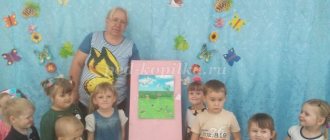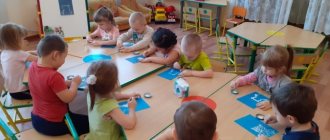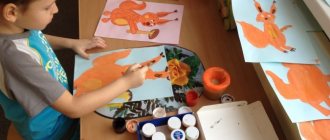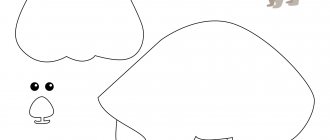Senior group. Senior preschool age. Children 5-6 years old
Abstract of the educational activity "Journey to the land of mathematics with Masha and the Bear" using ICT for children of the older group. Abstract of the educational activity using ICT for children of the older group. Topic: “Journey to the land of mathematics with Masha and the Bear”
. The goal is to consolidate the ordinal count within 7. Objectives: educational: to consolidate the ordinal count within 7; learn to correlate numbers with the number of objects….
The use of ICT in classes on speech development in the senior group Introduction: Today, with the development of computer technology and mass computerization of the population, when each person spends an average of 4 hours on social networks, children are introduced to modern gadgets at an early age. When a child communicates with a phone or tablet...
Summary of GCD on FCCM using ICT in the senior group “Journey to the Forest”
•Do not shoot birds with slingshots.
•Do not catch birds, do not take chicks home.
Lesovik:
I have a small gift for you. Listen to him (the voice of a nightingale sounds, a video of a nightingale appears on the interactive board) This is a nightingale, not everyone manages to hear it in the forest.
Educator:
Thank you Lesovichok, this is a very good gift, now let’s rest, (a recording of sounds of the forest plays)
Physical exercise.
They raised their hands and shook them - these are trees in the forest.
Elbows bent, hands shaken - the wind knocks down the dew.
We wave our hands smoothly - the birds are flying towards us.
Let us show you how they sit down: their wings are folded back.
Lesovik: Well done guys, they made me happy. Can you handle the next task? Guys, besides birds, who else lives in the forest?
Children:
Wild animals live in the forest.
Educator:
Let's show Lesovich how we know wild animals. We'll play games now.
•Game “Four wheel” (animals)
•Game “Cut pictures” (animals)
Lesovik:
Yes, guys, many living creatures live in my magical forest, it’s impossible to list them all. Guess some of them.
All four petals of the flower were moving.
I wanted to pick it off - it fluttered up and flew away. (butterfly)
Look at the fellows: cheerful and lively.
Material for construction is dragged from all sides. (ants)
Black, not a raven, horned, not a bull. with wings, not a bird. (bug)
From branch to path, from grass to blade of grass.
A spring jumps, a green back. (grasshopper)
A housewife flies over the lawn.
If he fusses over a flower, he will share the honey. (bee)
Blue airplane sitting on a white dandelion (dragonfly)
It will hit, weave, sit and wait for prey. (spider)
(as you solve riddles, images of insects appear on the interactive board)
Lesovik:
Well done guys, you have proven that you know a lot about the forest, its inhabitants, and you can behave well in the forest. Guys, be sure to come visit again, you can learn a lot of interesting things about the forest. You made me happy today, I want to reward you with these “Friend of Nature” medals. As a parting gift, I give you this book (about the forest).
(children say goodbye to Lesovichok)
Educator:
Well, guys, our journey has come to an end and it’s time for us to return to our beloved kindergarten. Let's close our eyes and turn around ourselves. Here we are in our group. Let's remember where we were? (We were in the forest) What did we do? (We found and explained signs about the rules of behavior in the forest. We named migratory and wintering birds. We talked about how we can help the birds. We played the game “Odd Four.” We played the game “Cut Pictures.” We guessed riddles).
Publication address:
MAGAZINE Preschooler.RF
Open GCD lesson using ICT in the senior group on the topic: “Hello, hedgehog!”For the implementation of educational areas “Artistic creativity” (drawing using non-traditional methods), “Cognition” (Formation of a holistic picture of the world), “Communication” (speech development)
Goal: to teach children to apply in practice the non-traditional drawing skills acquired in the classroom.
Tasks:
Educational: continue to teach how to describe the appearance and habits of animals by asking riddles. Clarify children's understanding of wild animals. Strengthen skills in working with non-traditional drawing methods. Reveal creativity when using paper and available materials in combination.
Educational: activate children's imagination and speech.
Educational: to develop children's cultural communication skills and humane feelings. Cultivate an interest in caring for living nature.
Material: computer presentation about the life of hedgehogs, wet wipes...
Preliminary work: talking about wild animals, looking at illustrations, asking riddles...
- Introduce children to unconventional drawing methods - imprinting with crumpled paper, drawing with forks, cotton swabs.
- development in children of cognitive interest in nature, ideas about the dependence of the existence of a particular animal on environmental conditions.
- expand children’s knowledge about the possibilities of paper (not only can you draw on it, but you can also draw on it).
- develop fine motor skills of the hands, teach to strengthen the fine muscles of the fingers through Su-Jok gymnastics.
- Cultivate interest in fine arts, accuracy in drawing
Task:
Learn
Equipment and materials:
- A-4 size sheets of paper
- gouache brown, black, green, red, yellow
- paper napkin
- plastic forks, 2 pcs.
- cotton swabs 3 pcs.
- wet wipes
- Sujok balls
- soft toy hedgehog
- interactive box
- magnetic board
- presentation - hedgehog
Methodical techniques:
- conversation-dialogue, use of art. words, playing with a toy
Preliminary work: reading M. Prishvin’s story “Hedgehog” , looking at paintings from the wild animals series, conversation
The author of the article is teacher of kindergarten No. 11 “Baby” Olga Vladimirovna Lucheva, Lukhovitsy
Progress of the lesson:
Q. Hello guys! Today is an unusual day for you. Guests have come to see you. Everyone come to me, turn to face the guests, say hello to them.
Children: Hello!
Educator: Let's introduce ourselves to our guests.
D. We are kids from kindergarten, We are preschool kids, We all come here in the morning, here we dance and sing.
In kindergarten we are all friends. After all, we cannot live without friendship!!!
V. Well done guys, now come to me, I’ll tell you something now.
Today I went to the group, I found a magic box in the group, the box is not simple, it contains a secret and together with you we will find out the answer to it.
This box can tell riddles. Let's listen to her carefully.
V. offers the children a riddle:
Angry touchy lives in the wilderness of the forest There are a lot of needles. And not a single thread (hedgehog)
Who are these guys?
Of course it's a hedgehog. I invite you to learn about the life of hedgehogs in the forest. Let's go.
D + V. One, two, three, four, five 1,2, 3,4, 5 we want to know everything about hedgehogs.
A film about a hedgehog.
Q. You and I watched the film, now answer my questions
Questions for children after watching the film:
- Where do you guys think hedgehogs live?
- What kind of life does a hedgehog lead?
- Do hedgehogs have enemies in nature?
- What does a hedgehog eat?
- Why is it dangerous for a hedgehog to be in water?
- Why does a hedgehog need needles?
Q. Children, we remembered and learned a lot of interesting things, and now let’s rest a little.
Physical education minute.
There lived a prickly hedgehog in the forest, He was a ball and without legs, (They hug themselves by the shoulders.) He didn’t know how to clap - Clap-clap-clap, (They clap their hands.) He didn’t know how to stomp - Top-top-top. (Perform “stompers”.)
He didn’t know how to jump - Jump-jump-jump (They jump on two legs.) Just move their nose - Sniff-sniff-sniff And the kids came to the forest, They found a hedgehog in the forest, (Walking in place.)
They taught you to clap - Clap-clap-clap, (Clap your hands.) They taught you to stomp - Top-top-top. (They perform “stompers.”) They taught them to jump - Jump-jump-jump, (They jump on two legs.) They taught them to run... (They run in place.)
V. Well done, guys! You now know a lot about hedgehogs. And most importantly, I am sure that none of you will ever offend a hedgehog.
- Let's play with the hedgehog.
6. Game “Finish the sentence” (They pass the hedgehog to each other in a circle)
- The hare is fluffy, and the hedgehog... (prickly)
- The hedgehog sleeps during the day and hunts... (at night)
- The squirrel lives in a hollow, and the hedgehog... (in a hole)
- The fox has cubs, and the hedgehog... (hedgehog) +
- the bear is big, and the hedgehog... (small)
- the dog is a domestic animal, and the hedgehog (wild)
- The hare has long legs, and the hedgehog has short legs.
- The piglet grunts and the hedgehog (snorts)
- The snake crawls and the hedgehog (runs)
- The fish are happy in the water, but the hedgehog is dangerous
Well done, you did a great job, but the hedgehog
one is bored in the clearing, how can one help him?
Let us invite him to our creative workshop. And we’ll draw him a lot of friends – hedgehogs, so that he won’t be bored alone in the forest.
Come in and take your seats.
- We will be artists today. But before we get to work, we will prepare our hands. We will do gymnastics using a massage ball.
Finger game "Hedgehog"
Description: the exercise is performed first on the right hand, then on the left.
Hedgehog, hedgehog, cunning hedgehog, you look like a little ball. (children roll Su Jok between their palms) The needles on the back are very, very sharp.
Even though the hedgehog is small in stature, he showed us the spines, and the spines also look like a hedgehog
But today we will draw in an unusual way. Look at your tables, there are napkins, forks, and cotton swabs. Take Shows how you can complete the face and paws using cotton swabs. We will make needles for him using a fork. What else can you draw with a fork (grass). Let's glue the eye.
The children get to work.
Now bring me your finished work.
At the end of the lesson, the teacher, when examining the work, draws the children’s attention to what kind of friends the hedgehog turned out to be, hedgehogs are so different, not similar to each other.
What did you guys learn new and interesting about yourself today?
Guys, where have we been?
What did we do there?
What did you like best?
What do you remember?
Now let’s say goodbye to the guests and go to the group.
And the hedgehog liked his friends and your poems about him so much that he prepared a surprise for you, these mushrooms.
Thanks a lot, everyone!!!!
| Next > |




